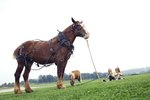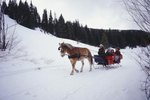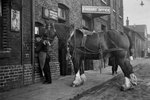Whether three- or five-gaited, the American saddlebred is the show horse par excellence. These flashy, high-stepping equines trace their lineage back to the earliest colonies on the Eastern Seaboard. They also served as transportation animals throughout the South and Midwest. During the Civil War, Union and Confederate officers rode American saddlebreds.
Ancestors
The modern saddlebred descends primarily from breeds brought to American shores by British colonists. One -- the thoroughbred -- is among the most recognizable breeds in the world, both on and off the racetrack. The others include the gaited Hobby and Galloway horses, which contributed to an early American breed, the Narragansett Pacer. The Narragansett Pacers, which no longer exist, were the everyday riding and driving horses of young America. When crossed with thoroughbreds, the resulting offspring combined thoroughbred beauty with the Narragansett Pacer's natural gaits and even temperament. By the time of the American Revolution, the thoroughbred/Narragansett Pacer-type cross was quite recognizable and was referred to as the "American" horse. As the pioneers headed west, so did the American horse. A particularly good-looking, easily-gaited version became known as the Kentucky saddler.
Foundation Sires
The thoroughbred Denmark, foaled in 1839, is one of the foundation sires of the American saddlebred. The thoroughbred Messenger, the sire of Hambletonian, is the foundation sire of another American breed, the standardbred. Harrison Chief, also an American saddlebred foundation sire, traces back to Messenger lines. The saddlebred developed with crosses to another American breed, the Morgan, along with the British hackney.
The Civil War
Confederate Gen. Robert E. Lee rode his famous gray, Traveller. One of Union Gen. U.S. Grant's mounts was the huge Cincinnati. Both were American saddlebred types with significant thoroughbred blood. Gen. Thomas "Stonewall" Jackson rode Little Sorrel, also a saddlebred type but from pacing bloodlines. After the Civil War, horse shows featuring saddlers gained in popularity. The horses were shown at the standard walk, trot and canter, along with additional gaits including the running walk and rack.
American Saddlebred Horse Association
Although the saddlebred type had been recognized for generations, it wasn't until 1891 that a formal breed organization, the American Saddlebred Horse Association, came into being in Louisville, Kentucky. Besides registering horses fitting breed criteria, the group researched pedigree information and the history of the American saddlebred. Currently based in Lexington, Kentucky, the association continues to register purebred American saddlebreds and promote the breed.
The Modern Saddlebred
Today's American saddlebreds, though best known as saddle seat and fine harness show horses, possess the athleticism and versatility to compete in dressage, eventing, combined driving and other equine pursuits. All colors are permissible, with horses ranging between 800 and 1,200 pounds and in height from 14 to 17 hands. The classic American saddlebred boasts a fine, long neck; refined head; sloping pasterns; level back and a high-carried tail. He exudes presence, boasting a true star quality.
References
- American Saddlebred Horse Association: What’s American Saddlebred?
- Illinois American Saddlebred Pleasure Horse Association: History of the American Saddlebred Horse
- American Saddlebred Horse Association: Breed History
- American Saddlebred Association of Wisconsin: The American Saddlebred -- The Horse With an American History
- American Saddlebred Horse Association: Breed History 1800's
Writer Bio
Jane Meggitt has been a writer for more than 20 years. In addition to reporting for a major newspaper chain, she has been published in "Horse News," "Suburban Classic," "Hoof Beats," "Equine Journal" and other publications. She has a Bachelor of Arts in English from New York University and an Associate of Arts from the American Academy of Dramatics Arts, New York City.





